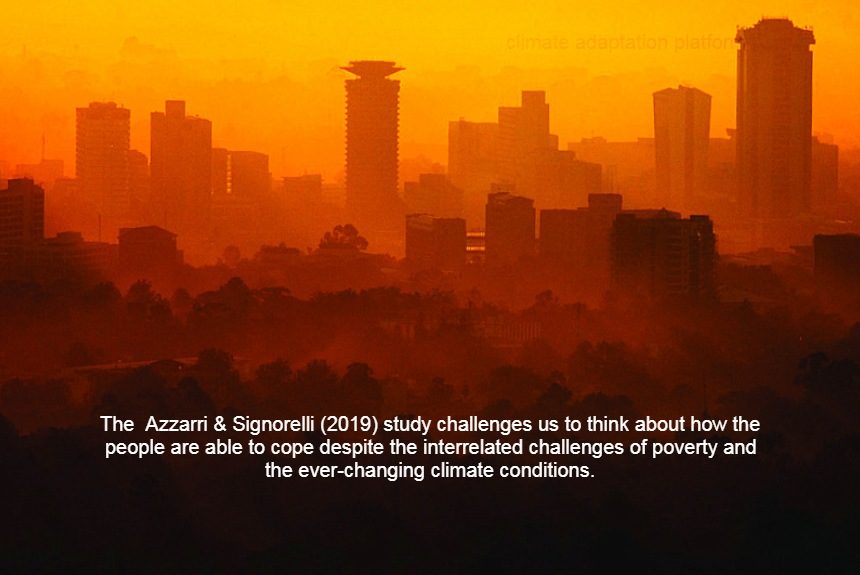According to a study on climate and poverty in Sub-Saharan Africa, the region is home to the world’s extremely poor populations and is identified as very vulnerable to climatic shocks or extreme weather conditions. Scientists project that because of the continuing negative effects of climate change in agriculture, these people will not likely get out of poverty (Azzarri & Signorelli, 2019).
Published in 2019, the “Climate and poverty in Africa South of the Sahara” study by Azzarri & Signorelli mentions the following:
- The World Bank also estimates that a hundred million people around the globe are at risk of falling back into poverty as a direct result of climatic events. The most affected households will be in South Asia and the SSA.
- In the past, studies on poverty in Africa have been conducted at the country or national level. This overlooks the regional differences in poverty and even the geographic groupings of well-being that exist at the subregional level.
- The study conducts a household survey of 24 countries in Africa and Sub-Saharan Africa (SSA), representing more than half of the African population and two-thirds of the SSA. It looks at how long-term climatic conditions and year-specific shocks affect their income, food consumption, and spending.
- The countries included in the study are Angola, Burkina_Faso, Burundi, Cameroon, Cote d’Ivoire, Congo DRC, Ethiopia, Ghan, Kenya, Lesotho, Madagascar, Malawi, Mali, Mauritania, Mozambique, Niger, Nigeria, Rwanda, Senegal, South Africa, South Sudan, Tanzania, Uganda, and Zambia. Countries living in Congo DRC, some areas in Tanzania, Zamia, and Malawi, Madagascar, Nigeria and Niger, some regions of Northern Ghana are those who are living in extreme poverty.
- Usually, these very poor households live in the driest villages in dry areas and the wettest villages in wet areas.
- The study shows that the average rainfall across Africa has declined since the 1950s, while temperature has steadily increased.
Azzarri & Signorelli (2019) say, “What is interesting about the study’s findings is that drought and heatwaves do not seem to have a devastating effect on well-being in some areas of Sub-Saharan Africa; in fact, the opposite is true. For example, droughts are associated with better outcomes in West Africa and heatwaves are associated with improved outcomes in Central Africa. Positive outcomes here refer to the amount of food consumption and expenditure. This positive outcome is probably the result of the wide distribution of drought-tolerant crops and better farming adaptation practices to rain shortages.”
Other research findings
- Humid areas increase the well-being of the community because higher moisture benefits crop growth and productivity. Populations living in humid areas also spend more on food and reduce extreme poverty rates than those living in drier areas.
- Flood shocks and excessive rains have the most detrimental effects on well-being, lowering food consumption and expenditures by 35% and increasing poverty by 17%.
- These findings show that households in the study are more resilient to drought than to extreme flooding.
- The study also reveals that smallholder farmers are the most vulnerable to climate variability and the poorest of all groups, compared to largeholder farmers and non-farming households. This finding is important because 80 per cent of food supplies in the SSA and Asia are produced by small-scale family farmers. So, not only will climate change affect food supplies, but it will also affect a significant portion of the population in SSA.
- Lastly, the study finds that future increases in weather shocks associated with climate change have an alarming effect on the regional poverty rate across Africa.
- Because the effects of climatic events are experienced differently in each region, some regions benefit from heat waves while others benefit from more humid climates. The study recommends locally specific adaptation and mitigation strategies in the different areas of Africa.
Climate adaptation Africa
The Azzarri & Signorelli (2019) study challenges us to think about how people cope despite the interrelated challenges of poverty and ever-changing climate conditions. Sustainable climate adaptation strategies are also needed in these places.
The Food and Agriculture Organization provides pilot projects on climate adaptation related to land and water management in Ethiopia, Kenya, and Tanzania. It targets over 15,000 households as direct beneficiaries and aims to strengthen their adaptive capacity to climate change (Towards Climate Change, 2020).
These projects focus on increasing soil health, harvesting water, livelihood diversification, and networking and capacity building (Towards climate change, 2020).
Sources:
Azzarri, C. & Signorelli, S. (2019, October 4). Climate and poverty in Africa South of the Sahara. World Development. Volume 125. Retrieved from https://www.sciencedirect.com/science/article/pii/S0305750X19303390
Towards climate change adaptation in sub-Saharan Africa (2020). Food and Agriculture Organization of the United Nation. Retrieved from http://www.fao.org/in-action/towards-climate-change-adaptation-in-sub-saharan-africa/en/



Leave a Reply